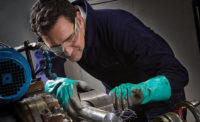A field test that involved placing an N95 respirator-wearing manikin at multiple sites and testing exposures using a nanoparticle counter found that while the respirator reduced exposures, in many situations it did not provide 95% protection.
Researchers positioned the manikin near concrete drilling and grinding activities, earthmoving, and woodcutting and used a commercially available nanoparticle counter to collect air samples and measure potential worker exposures and respirator efficiency.
Key findings
Different construction tasks can release different levels of airborne nanoparticles and ultrafine particles of 11.5 – 365.2 nm sizes ranging from 103 to 105 particles/ cm3 (number concentration) and 1.41 to 99.96 µg/m3 (mass concentrations).
The field experiments in this study showed that concrete blasting and grinding activities can release more nanoparticles than wood building framework construction and soil moving activities on construction sites.
N95 respirators may not provide 95% protection for all categories of nanoparticles and generally 95% protection is achievable for particles of 11.5 to 20.5 nm sizes.
Morphology of nanoparticles differed by task. Porous silicious nanoparticles, however, were not as prevalent in the outdoor concrete blasting and grinding site as anticipated.
CLICK HERE for a summary of Field Evaluation of N95 Filtering Facepiece Respirators on Construction Jobsites for Protection against Airborne Ultrafine Particles. The study, which grew out of exploratory research conducted as a CPWR Small Study, is published in International Journal of Environmental Research and Public Health.



